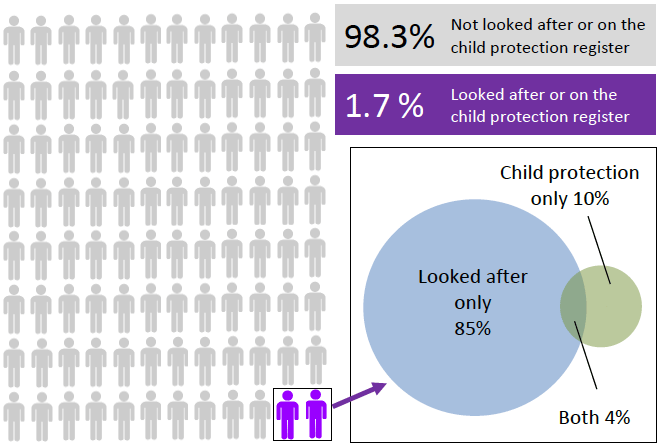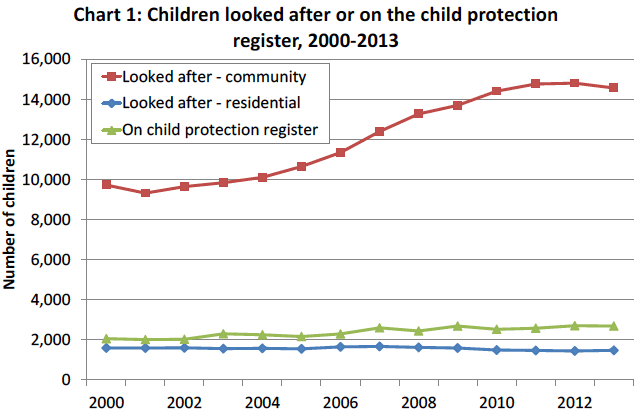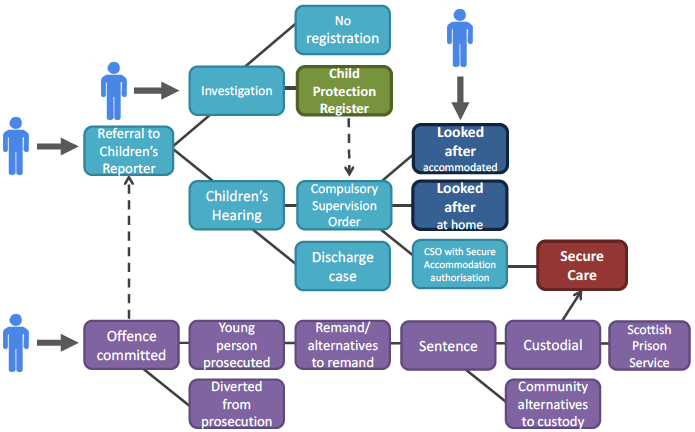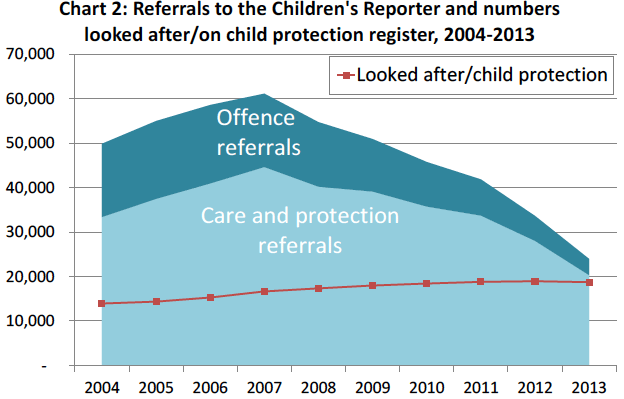Children's Social Work Statistics Scotland, 2012-13
statistics on children looked after, child protection and young people in secure care and close support accommodation
This document is part of a collection
Main Statistics
Each figure represents approximately 11,000 of the one million[1] children under 18 in Scotland. In July 2013:
2% of children in Scotland were looked after by local authorities or on the child protection register
16,041 children were looked after
2,681 children were on the child protection register of whom
805 were also looked after
78 young people were in secure care accommodation
What are the general trends?
Children who are looked after by local authorities can be accommodated in a community placement (e.g. at home with parents, with family/friends or foster carers) or a residential placement (e.g. in a local authority or voluntary home, in a residential school). There was a 49 per cent rise in the number of children looked after between 2001 and 2011, driven by the increase in children looked after in community placements. Since 2011 numbers of looked after children have plateaued and started to decrease.
Since 2001 there has also been a less steep but steady 34 per cent increase in the number of children on the child protection register. Of the 2,681 children who were on the child protection register at 31 July 2013, almost one in three (30 per cent) were also looked after at that point, a slight increase from 27 per cent in 2012.
Across Scotland two per cent of under 18s are looked after or on the child protection register, but there is variation across local authorities. The rate is highest in Glasgow, with three and a half per cent of children looked after or on the child protection register (35.5 children per 1,000 under 18s) and lowest in Shetland, with less than one per cent of children looked after or on the child protection register (6.4 per children per 1,000 under 18s). In general rates are higher in the West of Scotland and urban areas.
How do children come to be counted in these figures?
There are a number of routes by which a child may come to be looked after, in secure care or on the child protection register. Children may be referred to the Children's Reporter, be the subject of an investigation without being referred to the Reporter, become voluntarily looked after or come in through the criminal justice system. The diagram below gives a high level illustration of the main routes by which a child can become looked after, in secure care or on the child protection register. See background note 1.1 for more information.
What are the trends in other children's social work data?
Between 2004 to 2013 - a period in which the number of children who are looked after or on the child protection register has increased by 36 per cent - the number of children and young people referred to the Reporter decreased by more than 60 per cent[2]. The decrease is the result of falls in both the number of offence and non-offence referrals. Offence referrals now only account for 15 per cent all referrals, down from 33 per cent in 2003/04. As with the looked after and child protection statistics, younger children make up an increasing proportion of referrals.
How do the SCRA figures square with the findings in this publication?
The fall in referrals to the Reporter is likely due to pre-referral screening across many areas of the country leading to a reduction in referrals received by the Reporter where compulsory measures are not deemed necessary and a proportionate increase in referrals where they are deemed necessary.
The historic increase in the number of children who are looked after or on the child protection register at a time when referrals are falling means that the smaller number of referrals being received by the Reporter are potentially of a more complex nature and are more likely to end up being looked after or on the child protection register than in previous years. The plateau in numbers of children looked after and on the child protection register seen in 2012 and 2013 is likely to be linked to the fall in referrals starting to feed through to the later stages of the social work system.
Contact
Email: Carrie Graham
There is a problem
Thanks for your feedback



